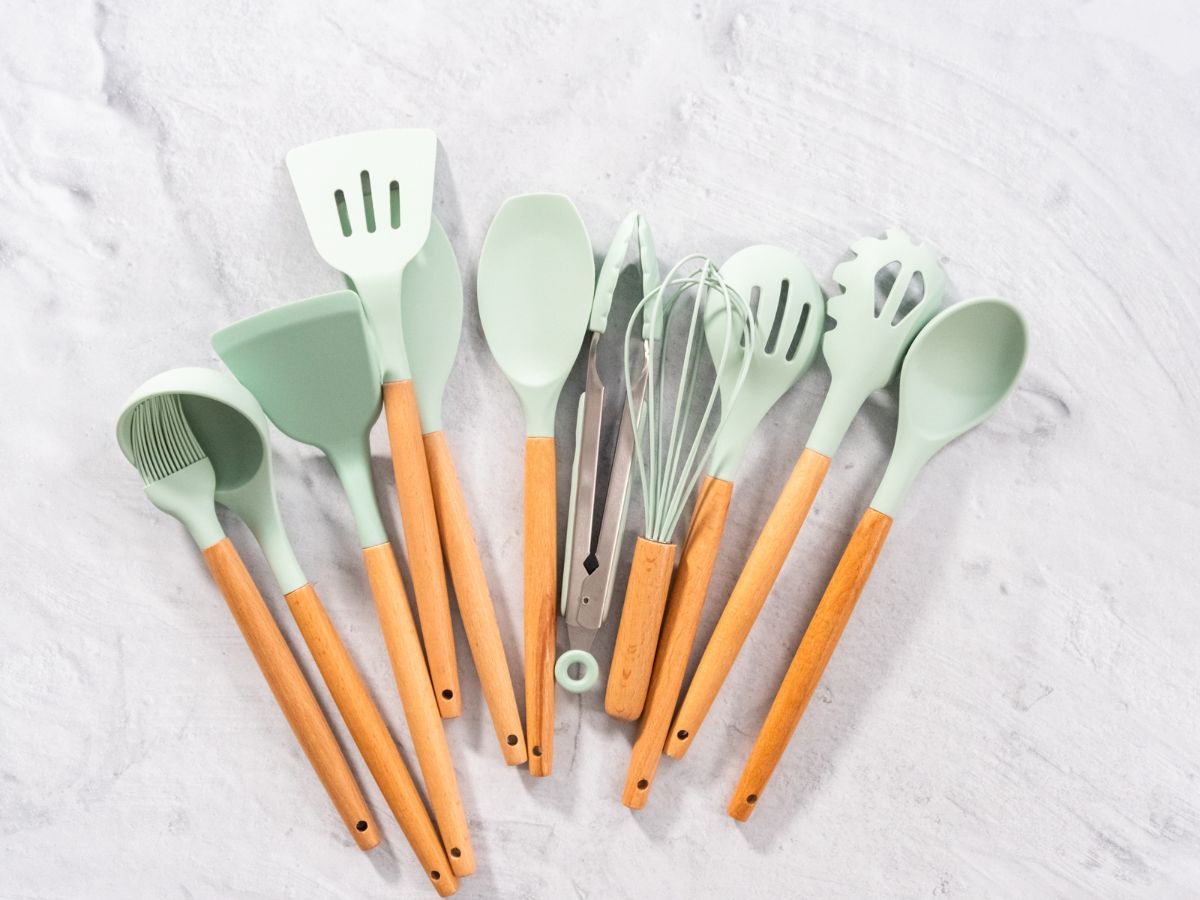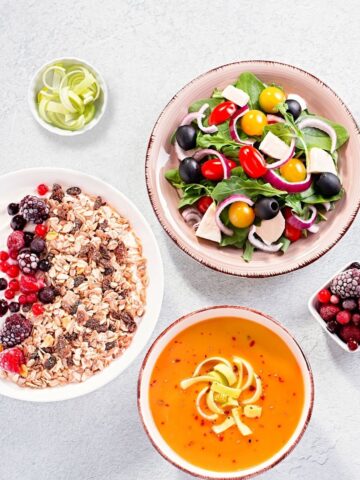When it comes to cookware, there are a lot of choices on the market. But, not all kitchenware is created equal. Some materials are prone to leaching, resulting in the release of toxins in your food. That's why I've put together a guide for you on the safest cooking utensils.

Above all, you want to make sure you are using safe, non-toxic materials. Whether you're looking at pots and pans or serving utensils, there are many different options on the market, and it can be overwhelming trying to choose which ones are right for you.
Luckily, as a holistic health and nutrition coach, I've done a lot of research on this topic. Keep reading to get a rundown on what the safest cooking utensils are in 2023.
I believe knowledge is power and I want you to make an informed decision about what's safest to use in your kitchen.
Jump to:
- Can kitchen utensils be toxic?
- How to choose non-toxic kitchenware
- What are the safest materials for kitchenware?
- What are the safest coatings for cookware?
- What materials should you avoid in cooking utensils?
- Are silicone kitchen utensils really safer than plastic?
- What is BPA and how does it affect humans?
- Are wood kitchen utensils better than silicone?
- Caitey Jay's Top Picks
- Fast Facts
- Similar articles
- Simple holistic recipes
Can kitchen utensils be toxic?
Most of us never give a second thought to the kitchen utensils we use on a daily basis. However, recent research has raised concerns about the safety of some common materials, such as plastic and nonstick coatings.
Some experts believe that chemicals in these products can leach into food and contribute to health problems. That's even more concerning when they're exposed to heat, which makes the kitchen an important place to start when trying to detox your home.
How to choose non-toxic kitchenware
One of the most important things to consider when choosing cooking utensils is the materials used to build them. Some materials, like aluminum, are thought to seep into food and cause potential health issues, while other are considered a safer bet.
Another thing to consider is the finish on a cooking utensil. Some finishes, like Teflon, are considered unsafe. Other finishes, like stainless steel, are much safer because they won’t leach into your food.
What are the safest materials for kitchenware?

There are several materials used to make cooking utensils that are generally considered to be safe. I've shared these below, along with some of their pros and cons.
- Stainless steel: Stainless steel cookware is a durable and safe option that can be used for most types of cooking. It is resistant to corrosion and easy to clean, making it a popular choice among professional and home chefs. Be sure to get high quality stainless steel, as low quality poses a risk of leaching.
- Cast iron: Cast iron pans and skillets are another durable and versatile option that can be used for a variety of cooking techniques. They can be a good choice because they are naturally non-stick when properly seasoned and can retain heat well, allowing for even cooking. They can also be transferred between stovetop and oven. There are some concerns that the naturally occurring iron can leach into foods and contribute to iron overload in some individuals, but you can avoid this by avoiding cooking acidic foods in your cast iron pans.
- Ceramic: Ceramic cookware is a non-toxic option that is generally safe to use at high temperatures. It has some natural non-stick properties, but oil will be needed to truly compete with non-stick coatings. This clay cookware is durable and resistant to abrasions and scratches. Try to purchase 100% ceramic, rather than non-stick ceramic or ceramic-coated. However, this can be found, so if buying coated, be sure it's PFOA and PFAS free.
- Glass: Glass is a non-reactive material that is safe for use in the oven, microwave, and dishwasher. It is also easy to clean and does not retain odors or flavors. However, it is not as durable as other materials and may be prone to breaking. Be sure to buy newer glassware, as older glassware did not have to follow the strict production standards set in North America, and may be less safe for use.
- Wood: Wood is a natural and non-toxic material that is safe for use in the kitchen. It is also resistant to heat and can be used for a variety of cooking tasks, including stirring and serving. However, it is not as durable as other materials and may be prone to staining and scratching.
- Silicone: Silicone is made from silicon, a naturally-occurring element that is safe for human use. Furthermore, silicone can handle very high temperatures and is highly resistant to leaching, making it a safer option for cooking and eating. In addition, silicone utensils are durable and easy to clean, making them a practical choice.
It's important to note that no matter what material you choose, you need to follow proper food safety guidelines, including washing your cooking utensils thoroughly and avoiding cross-contamination.
What are the safest coatings for cookware?
There are several options for safe kitchenware finishes. Generally, every material in the list above is considered safe, along with the additional mediums below.
- Enamel: Enameled kitchenware is made by coating metal (such as steel or cast iron) with a layer of enamel, a hard, glossy material made from glass and clay. Enameled kitchenware is durable and resistant to scratching and chipping. It doesn't breakdown at high temperatures or leach any harmful chemicals into food. It is also easy to clean and naturally non-stick.
- Non-stick cookware: Non-stick pans and pots can be a good choice because they allow you to cook with less oil or butter, which can be beneficial for heart health. However, it's important to use them correctly and avoid overheating, as high temperatures (above 450°F) can cause the non-stick coating to break down and release potentially harmful chemicals. Also, be sure to buy newer kitchenware, as PFOA is no longer used in non-stick coatings due to health concerns.
What materials should you avoid in cooking utensils?

It's good to be aware of the materials that should be used when selecting a good cooking utensils. But, it's equally important to become familiar with the materials that should be avoided.
There are a several materials that may be considered unhealthy for cooking utensils due to their potential to release harmful chemicals or toxins into food. Below is the list you should be familiar with:
- Aluminum: While aluminum is an affordable, lightweight material that is commonly used in cookware because it is a good heat conductor, it can be harmful if it leaches into food. This is particularly problematic with uncoated and non-anodized aluminum kitchenware. Some studies have suggested that high levels of aluminum intake may be linked to an increased risk of developing certain health conditions, including Alzheimer's disease and kidney problems.
- Copper: While beautiful, uncoated copper cookware is highly reactive and can leach into food, especially when it comes into contact with acidic ingredients. Consuming high levels of copper can cause nausea, vomiting, and other digestive issues. Tin or steel lined copper cookware is generally considered safer as it keeps copper molecules away from your food. If you go this route, be sure to use wood utensils as if the lining is scratched, it's no longer safe to use.
- Teflon and other non-stick coatings: Teflon and other non-stick coatings can be a convenient and safe option for cooking. However, these coatings can break down at high temperatures and release potentially harmful chemicals into the air and into your food. So, if you plan on using them at temperatures above 450°F, there is probably a safer option out there.
- Plastic: Plastic cooking utensils can release chemicals, such as BPA and phthalates, into food, especially when they are exposed to high temperatures. It is generally recommended to avoid using plastic cooking utensils and instead opt for safer materials, such as silicone, stainless steel or wood.
- Nylon: While nylon cooking utensils are generally safe, they can only withstand up to 400°F and begin to melt at higher temperatures. At this point, they start to leak and contaminate food.
Are silicone kitchen utensils really safer than plastic?

Silicone utensils have become increasingly popular in recent years due to the benefits they provide that plastic ones do not. Silicone is naturally non-stick, non-toxic, BPA-free, and virtually unbreakable – so, it's considered a far safer and a more durable choice over its plastic counterpart.
An added bonus: they are dishwasher safe for easy cleaning and don't absorb odors like plastic utensils.
What is BPA and how does it affect humans?
BPA, or bisphenol A, is a synthetic compound found in many plastic containers that can leech into food or drink when exposed to heat. Research has indicated that consuming BPA over time can have adverse effects on your health, including hormone imbalance and reproductive issues.
By opting for a BPA free product you can feel assured that what you’re putting into your body is safe and free from potentially hazardous synthetic compounds like BPA.
Are wood kitchen utensils better than silicone?

When it comes to kitchen utensils, two popular safe materials to use are wood and silicone. Each has its own advantages and disadvantages, so it's important to choose the right type of utensil for the task at hand.
Wood is a classic material that has been used for cooking utensils for centuries. It's sturdy and durable, and it can withstand high temperatures. However, wood is also porous, which means that it can absorb flavors and colors from food.
Silicone, on the other hand, is a modern material that is heat-resistant and non-porous. This makes it an excellent choice for cooking acidic or brightly colored foods, as there is no risk of the food absorbing into the utensil. However, silicone is not as durable as wood, and it can be damaged by sharp knives.
Caitey Jay's Top Picks
Ultimately, the best type of cooking utensil depends on your own personal needs. But I'll share my go-to kitchen utensils below.

Lodge Cast Iron 4-Piece Cookware Set
Buy Now →
Anolon Smart Stack Hard Anodized Nonstick Cookware
Buy Now → Buy Now →
Buy Now → 
Greenpan Ceramic Non-Stick Skillet
Buy Now →
Pyrex Glass Baking Dish Set (BPA free)
Buy Now → Buy Now →
Buy Now → Fast Facts
- Recent research suggests that it's possible that the utensils and tools we use everyday in our kitchen can pose a potential threat to our health.
- There are many things to consider when choosing the safest cooking utensils for your kitchen. The most important are the material they are made from and the finish on the cookware.
- The safest materials are glass, ceramic, stainless steel, cast iron, wood and silicon.
- Materials you may want to avoid include nylon, plastic, aluminum, copper and teflon.
Similar articles
Want to know know more about healthy cooking at home? Check out the articles below.
Simple holistic recipes
A holistic approach to nutrition isn't just about using safe utensils in the kitchen. It's also about eating clean food that's as close to its natural state as possible for optimum health and wellbeing. And, that's the philosophy I follow when creating recipes for Caitey Jay.
Feel free to check out the recipes I hand selected for you below or peruse my entire recipe collection here.
Have more questions about kitchen safety? Leave them in the comments below.










Leave a comment!